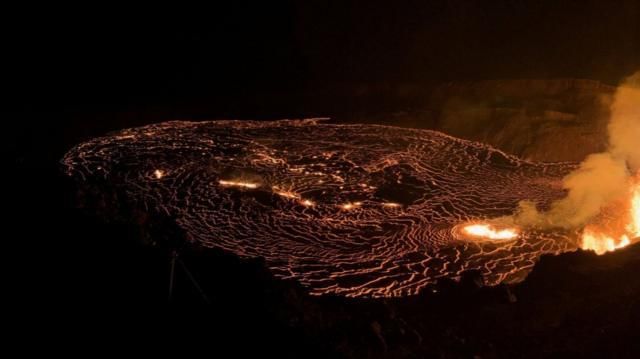UPSC Daily Current Affairs: 25th December 2024 | Current Affairs & Hindu Analysis: Daily, Weekly & Monthly PDF Download
GS2/International Relations
Greenland's Strategic Importance and Recent Developments
Source: Indian Express
 Why in News?
Why in News?The recent interest expressed by US President-elect Donald Trump in acquiring Greenland has reignited discussions about the island's geopolitical significance and its resources.
- Greenland is the world's largest non-continent island, strategically located between North America and Europe in the North Atlantic Ocean.
- It serves as an autonomous province of Denmark, previously a Danish colony.
Additional Details
- Geography:Greenland is surrounded by:
- The Arctic Ocean to the north
- The Greenland Sea to the east
- The North Atlantic Ocean to the southeast
- The Davis Strait to the southwest
- Baffin Bay to the west
- Climate: The island experiences extreme polar conditions, with winter temperatures dropping to -50°C and summer temperatures rarely exceeding 10-15°C, varying significantly across regions.
- Capital: Nuuk
- Strategic Importance: Greenland's value surged during the Cold War. The US operates the Pituffik Space Base (formerly Thule Air Base) there, allowing monitoring of potential missile threats from nations like Russia, China, and North Korea.
- Resource Richness: The island is abundant in rare earth minerals, essential for technologies such as mobile phones and electric vehicles, as well as military applications.
- Impact of Global Warming: Melting ice in the Arctic is expected to open new waterways, prompting increased interest from major global powers in the region.
In summary, Greenland's strategic location, resource wealth, and the implications of climate change make it a focal point of international interest, particularly for the United States.
GS2/International Relations
Bay of Bengal Initiative for Multi-Sectoral Technical and Economic Cooperation (BIMSTEC)
Source: PIB
 Why in News?
Why in News?Recently, delegates represented India at the 24th BIMSTEC Senior Officials' Meeting (SOM), which was hosted virtually by Thailand. This meeting addressed important regional issues and cooperation mechanisms among member states.
- The discussions centered on sustainable development, regional connectivity, security, and people-to-people exchanges.
- Several key documents were finalized, including Plans of Action for cooperation and new collaboration frameworks with external partners.
- Preparations for the upcoming 6th BIMSTEC Summit were also a significant focus of the meeting.
About BIMSTEC
- Members: The organization comprises 7 member states: Bangladesh, Bhutan, India, Myanmar, Nepal, Sri Lanka, and Thailand.
- Establishment: BIMSTEC was founded in 1997 to promote multifaceted technical and economic cooperation among countries bordering the Bay of Bengal.
- Population and Economy: The region has a combined population of approximately 1.5 billion and a GDP exceeding USD 3.8 trillion.
Origin
- Initially founded through the Bangkok Declaration, the organization began with four member nations under the name BIST-EC (Bangladesh, India, Sri Lanka, and Thailand Economic Cooperation).
- In 2004, Nepal and Bhutan joined, leading to the current name, BIMSTEC.
Key Features
- Establishment of BIMSTEC as a legal entity, allowing formal engagement with international organizations.
- Objectives include fostering trust and friendly relations among member states and promoting economic development and social progress.
- Defines a clear framework for regular meetings at various levels including ministerial levels.
- Provides for the inclusion of new members and observer states, facilitating growth and broader cooperation.
- Focuses on 7 sectors, each led by one member state:
- Trade, investment, and development
- Environment and climate change
- Security (including energy)
- Agriculture and food security
- People-to-people contacts
- Science, technology, and innovation
- Connectivity
Significance of BIMSTEC for Indo-Pacific Goals
- Maritime Connectivity: BIMSTEC enhances maritime ties among Bay of Bengal states, crucial for an open and inclusive Indo-Pacific.
- Regional Bridge: It links South Asia and Southeast Asia, aligning with India's "Act East" policy and promoting broader Indo-Pacific integration.
- Security Cooperation: Focuses on collaborative maritime security efforts, including counter-piracy and disaster management.
- Economic Integration: Promotes trade, investment, and infrastructure development to bolster economic growth in the Indo-Pacific region.
- Synergy with Other Frameworks: Complements initiatives like ASEAN and the Indian Ocean Rim Association, collectively advancing Indo-Pacific objectives.
Previous Year Question:
Do you think that BIMSTEC is a parallel organisation like the SAARC? What are the similarities and dissimilarities between the two? How are Indian foreign policy objectives realized by forming this new organisation?
This summary captures the essence and significance of BIMSTEC, illustrating its role in regional cooperation and its alignment with India's foreign policy goals.
GS2/Polity
Can the Constitution Protect Individual Dignity in Today's India?
Source: Indian Express
Why in News?
The Supreme Court (SC) has reaffirmed the importance of individual dignity within the context of Article 21 in several landmark judgments. Recently, former SC Justice Kurian Joseph highlighted that the Constitution prioritizes individual dignity, making this a significant topic in contemporary legal discussions.
- The Constitution of India aims to protect individual dignity through fundamental rights.
- Landmark cases have broadened the interpretation of individual rights under the Constitution.
- Societal attitudes and systemic issues affect the protection of individual dignity.
- Legal frameworks can adapt to evolving understandings of dignity.
Additional Details
- Entrenchment of Individual Rights:The Constitution guarantees rights aimed at protecting the freedom and dignity of citizens, such as:
- Right to Equality (Article 14)
- Right to Freedom (Articles 19-22)
- Right to Life and Personal Liberty (Article 21)
- Checks and Balances: The Constitution establishes mechanisms to prevent abuse of power. For instance, the Maneka Gandhi v. Union of India (1978) case expanded Article 21's scope, stating that laws affecting personal liberty must be fair and reasonable.
- Political Equality: The Constitution ensures political equality through Article 326, which guarantees universal adult suffrage, promoting political dignity.
- Societal Attitudes: Community identity can undermine individual dignity, especially when societal norms prioritize group identities over personal rights, leading to discrimination.
- Legal Adaptability: The Basic Structure Doctrine, established in Kesavananda Bharati v. State of Kerala (1973), protects core principles like dignity while allowing amendments for evolving needs, such as the 103rd Constitutional Amendment (2019) providing reservations for Economically Weaker Sections.
- Judicial Interpretation: Courts play a crucial role in interpreting dignity-related provisions. For example, the Navtej Singh Johar v. Union of India (2018) case decriminalized consensual same-sex relationships.
In conclusion, while the Constitution of India provides a robust framework for protecting individual dignity, societal attitudes and systemic issues remain significant challenges. Promoting constitutional values and empowering institutions can enhance the effectiveness of these protections.
GS2/Polity
India’s ‘Steel Frame’ Does Need a Check
Source: The Hindu
Why in News?
The recent government initiatives, such as Mission Karmayogi, aimed at enhancing the capacity of civil servants, underscores the ongoing dialogue about reforming India’s “steel frame” of governance.
Current State of India’s Bureaucratic Structure
India’s bureaucratic structure, particularly the Indian Administrative Service (IAS), has been crucial in administration but is now grappling with several challenges:
- Politicization: Frequent transfers and promotions based on political loyalty rather than merit undermine the professionalism and morale of IAS officers, hampering the development of domain expertise.
- Corruption and Inefficiency: India ranks moderately on the World Bank’s government effectiveness index, indicating persistent corruption and inefficiencies in policy implementation.
- Centralized Governance: The governance model under the Prime Minister has led to increased centralization of power in the Prime Minister’s Office (PMO).
Previous Efforts to Reform the Bureaucracy
- First Administrative Reforms Commission (1st ARC, 1966): Emphasized the need for specialization within the IAS to improve efficiency.
- Second Administrative Reforms Commission (2nd ARC, 2005): Proposed a transparent lateral entry process for domain experts and mandatory training throughout civil servants' careers.
- Mission Karmayogi (2020): A capacity-building program aiming to create a citizen-centric, future-ready civil service.
- Lateral Entry Reforms: Introduced to integrate specialized talent from diverse sectors into senior civil service roles.
Important Supreme Court Judgments
- T.S.R. Subramanian v. Union of India (2013): Barred civil servants from following oral political directives and mandated the creation of a Civil Services Board (CSB) for overseeing transfers and postings.
- Delhi Government Services Case (2023): Upheld Delhi’s legislative authority over services, reinforcing federalism and accountability of officers under the Delhi government’s jurisdiction.
Impact of Proposed Reforms
The proposed reforms aim to modernize India’s bureaucracy by enhancing independence, accountability, and specialization among civil servants:
- Lateral Entry Initiatives: Introduced to bring in domain experts from outside the traditional IAS framework.
- Performance-Based Promotions: Recommendations suggest linking promotions to measurable performance rather than seniority.
- Protection Against Arbitrary Transfers: Proposals aim to safeguard bureaucrats from politically motivated transfers.
Risks of Centralizing Decision-Making
- Reduced Autonomy: Centralization diminishes the independence of senior bureaucrats, making them susceptible to political pressures.
- Bottlenecks in Implementation: A centralized approach may create bottlenecks in policy implementation, slowing responses to emerging challenges.
- Neglect of Bureaucratic Expertise: Sidelining bureaucratic insights risks underutilizing valuable expertise within the civil service.
Way Forward
- Empower Decentralized Governance: Strengthen local and state-level administrative autonomy to enable more responsive governance.
- Implement Performance-Based Reforms: Institutionalize meritocratic measures to foster accountability and specialization among civil servants.
- Efficient Bureaucracy: Learn from proposed initiatives like the Department of Government Efficiency (DOGE) to enhance bureaucratic efficiency.
Overall, reforming India’s bureaucracy is essential for ensuring effective governance and accountability in public administration.
GS3/Environment
Kilauea Volcano
Source: The Guardian
 Why in News?
Why in News?The Kilauea Volcano, located on Hawaii's Big Island, is once again making headlines due to its recent eruptions. As one of the world's most active volcanoes, Kilauea's activity is significant for both geological studies and local communities.
- Kilauea is the youngest and most active Hawaiian shield volcano.
- The volcano is located within Hawai'i Volcanoes National Park.
- It has a strong mythological connection to the Hawaiian fire goddess, Pele.
- Historical activity includes 34 eruptions since 1952, with nearly continuous activity from 1983 to 2018.
Additional Details
- Summit Caldera: The summit caldera of Kilauea is a large depression that is approximately 3 miles long and 2 miles wide, covering over 4 square miles.
- Proximity to Mauna Loa: Kilauea's slopes merge seamlessly with those of Mauna Loa, making this region home to two of the world's most active volcanoes.
- What is a Shield Volcano? A shield volcano is characterized by broad, gentle slopes formed from highly fluid basalt lava. Unlike composite volcanoes, shield volcanoes are elongated and dome-shaped, with eruptions typically low in explosivity.
- Examples of Shield Volcanoes: Notable Hawaiian shield volcanoes include Kilauea and Mauna Loa.
In summary, Kilauea continues to be a focal point for volcanic activity in Hawaii, attracting attention for its geological significance and cultural importance.
GS1/Indian Society
Decline in Domestic Migration in India
Source: Times of India
Why in News?A report by the Prime Minister’s Economic Advisory Panel (EAC-PM) indicates a significant decrease of approximately 12% in the number of domestic migrants since the 2011 census, bringing the total to around 40.20 crore in 2023. This decline suggests a shift in migration trends, potentially linked to improvements in local opportunities.
- The estimated number of domestic migrants has fallen from 45.57 crore in 2011 to 40.20 crore in 2023.
- The migration rate has decreased from 37.64% of the total population in 2011 to 28.88% in 2023.
- Short-distance migration has become more prevalent.
- Key origins of migration include regions surrounding major urban centers such as Delhi, Mumbai, Chennai, Bangalore, and Kolkata.
Additional Details
- Internal/Domestic Migration: This term refers to the movement of people within India from one region to another, influenced by various push and pull factors.
- Push Factors: Reasons driving people away from their origin include lack of job opportunities, natural disasters, and inadequate education and healthcare.
- Pull Factors: Economic opportunities, a higher standard of living, and peace attract individuals to new regions.
- Key Findings: The report highlights states like West Bengal and Rajasthan as emerging destinations for migrants, while Andhra Pradesh and Bihar have seen a decline in their roles as sources of migration.
- Welfare Programs: The Indian government has initiated various programs to support migrant workers, including the Pradhan Mantri Shram Yogi Maan-Dhan Yojana and Ayushman Bharat Pradhan Mantri Jan Arogya Yojana.
The decline in domestic migration may reflect improved local opportunities, enabling individuals to find sufficient work and resources close to home. Additionally, the dominance of short-distance migration indicates a trend towards local mobility rather than long-range migration.
GS2/Polity
Supreme Court Restrains ED from Accessing Seized Digital Devices
Source: Times of India
 Why in News?
Why in News?In a significant ruling, the Supreme Court has barred the Enforcement Directorate (ED) from accessing and copying data from electronic devices seized during a raid on Santiago Martin, known as the "lottery king," along with his relatives and employees. This landmark decision emphasizes the protection of fundamental rights, particularly the right to privacy, and may shape future protocols regarding the seizure of digital devices.
- The Supreme Court's decision highlights the importance of privacy rights in legal proceedings.
- The ruling may set a precedent for digital evidence handling in future investigations.
- Concerns over potential misuse of investigative powers were raised in the petition.
Additional Details
- Enforcement Directorate (ED): The ED is a specialized financial investigation agency under the Department of Revenue, Ministry of Finance, responsible for enforcing laws such as the Foreign Exchange Management Act, 1999 (FEMA) and the Prevention of Money Laundering Act, 2002 (PMLA).
- Case Background: The ED conducted searches at multiple locations based on allegations against Future Gaming and Hotel Services Pvt Ltd for monopolizing the lottery business in Meghalaya, resulting in the seizure of ₹12.41 crore in cash.
- Supreme Court's Order: The Court issued a two-page directive preventing the ED from accessing or copying data from seized devices and stayed summons under the PMLA related to data extraction.
- Implications for ED Investigations: Although described as "unprecedented," ED officials maintained that the ruling would not impede their investigations due to other available evidence.
- Broader Concerns: The petition emphasized the need for guidelines to protect privacy rights during the seizure of digital devices, as sensitive information was involved.
The Supreme Court's ruling underscores the critical need to balance law enforcement objectives with constitutional rights, particularly as personal and business data increasingly becomes digital. This decision may pave the way for clearer guidelines on the treatment of digital evidence in future investigations.
GS3/Environment
How Regenerative Farming Can Safeguard Our Soil
Source: Indian Express
 Why in News?
Why in News?India, with a population of 145 crore, has made significant progress towards self-reliance in food and nutrition over the past seven decades. However, current agricultural practices are increasingly unsustainable, leading to soil degradation and ecological damage.
- Overuse of chemical fertilizers has severely degraded soil health.
- The economic cost of soil degradation is approximately ₹47.7 lakh crore ($564 billion) over 70 years.
- Regenerative farming practices can improve soil health and enhance agricultural productivity.
Additional Details
- Soil Degradation: Reliance on synthetic fertilizers has decreased soil organic carbon from 2.4% in 1947 to 0.4% today, undermining its arability and ability to sequester carbon.
- Economic Costs: Annual losses due to soil degradation amount to ₹68,243 crore ($8.06 billion), compounded by ₹2 lakh crore ($25 billion) in government subsidies for synthetic fertilizers, which promote inefficient usage.
- Environmental Impact: Current practices lead to 25 million tonnes of greenhouse gas emissions per year, costing ₹14,813 crore ($1.75 billion), and deplete natural resources.
- Food Security Risk: If trends continue, India may face food shortages by 2035, driven by a growing population and declining soil productivity.
- Social and Health Costs: Chemical inputs contaminate water and food, affecting public health and trapping farmers in debt cycles.
To counter these challenges, India must adopt regenerative farming practices that prioritize ecological health and sustainability. This transition is crucial for safeguarding food security and promoting environmental stewardship for future generations.
GS3/Environment
California Ground Squirrels
Source: CNN
 Why in News?
Why in News?Recent research has challenged the common perception of squirrels as strictly herbivorous, revealing that they are actually opportunistic omnivores capable of hunting and consuming small animals.
- California ground squirrels belong to the species Otospermophilus beecheyi and Otospermophilus douglasii.
- They are prevalent in home gardens across California and are considered pest species.
- These squirrels exhibit a range of behaviors, including hunting small rodents like voles.
Additional Details
- Habitat: California ground squirrels are primarily found in the western United States, particularly in areas like Briones Regional Park.
- Physical Characteristics: They have mottled fur with shades of gray, light and dark brown, and white, and typically live up to 6 years in the wild.
- Predators: Common threats include rattlesnakes, eagles, raccoons, foxes, badgers, and weasels.
- Conservation Status: Listed as Least Concern on the IUCN Red List; they have no special status under CITES.
- Behavioral Findings: In a study of 74 observed interactions, 42% involved the squirrels actively hunting.
This new understanding of California ground squirrels highlights their adaptability and complex behaviors, emphasizing the importance of reevaluating our perceptions of wildlife.
GS3/Science and Technology
What is Quantum Computing?
Source: The Hindu
Why in News?A recent study by IBM indicates a surge in interest towards quantum computing in India, fueled by active involvement from students, developers, and academic institutions.
- Quantum computing utilizes the principles of quantum mechanics to tackle problems that are too complex for traditional computers.
- Quantum mechanics studies the behavior of particles like atoms, electrons, and photons at microscopic levels.
- Key phenomena include superposition and entanglement, which empower quantum computers with unique capabilities.
Additional Details
- Fundamental Differences: Unlike classical computers that use binary bits (0 or 1), quantum computers employ quantum bits (qubits), which can exist in states of 0, 1, or both simultaneously due to superposition.
- This allows quantum computers to perform many calculations at once, significantly outperforming classical systems.
- Example: A qubit is akin to a spinning coin, representing both heads and tails until observed.
- Entanglement: A phenomenon where qubits become interconnected, so the state of one qubit can instantly affect another, no matter the distance, thus enhancing computational speed.
Milestones in Quantum Computing
- Origin: The concept was proposed in 1982 by Richard Feynman to address the limitations of classical computers in simulating quantum systems.
- Breakthrough Algorithm: Shor’s Algorithm (1994) changed the landscape of cryptography by factoring large numbers much faster than classical techniques.
- Technological Advancements:
- IBM Q System One (2019): The first commercially available circuit-based quantum computer.
- Google Sycamore Processor (2019): Achieved quantum supremacy by completing a task in 200 seconds that would take classical supercomputers around 10,000 years.
- Google Willow Quantum Chip (2023): Introduced scalable error-corrected qubits, completing complex computations in minutes that would take classical systems billions of years to finish.
Quantum computing represents a revolutionary leap in technology, with the potential to redefine problem-solving across various fields by leveraging the unique properties of quantum mechanics.
GS2/Polity
Recent Appointments of Governors in India
Source: The Hindu
Why in News?
The President of India has recently appointed two new Governors and reshuffled three others, reflecting changes in the governance of various states.
- The Governor acts as the chief executive head of a state, appointed by the President of India.
- The role of the Governor is independent, ensuring constitutional authority and governance.
Additional Details
- Governor's Role: The Governor is based on the Canadian model and functions as an independent constitutional authority. They are appointed under the President's warrant and hold office at the President's pleasure, enjoying a degree of independence in their role.
- Legal Protections: Under Article 361, the Governor has personal immunity from legal liability for official acts and cannot be arrested or imprisoned during their tenure.
- Recent Appointments:
- Ajay Bhalla, former Union Home Secretary, appointed as the Governor of Manipur.
- General V.K. Singh (Retd.), former Union Minister, appointed as the Governor of Mizoram.
- Arif Mohammed Khan transferred from Kerala to Bihar; Rajendra Vishwanath Arlekar appointed as the new Governor of Kerala.
- Hari Babu Kambhampati, Governor of Mizoram, appointed as the Governor of Odisha.
These appointments are crucial for ensuring effective governance and maintaining the constitutional framework within the states.
|
53 videos|5389 docs|1140 tests
|





















